31 Evidence-Based Benefits of Asparagus
What is Asparagus
Succulent and tender, asparagus has been a renowned delicacy since ancient times.
The plant has fine, feathery foliage and is cultivated for its edible shoots.
It is often used for medicinal purposes since it is jam-packed with nutrients and health benefits.
It has next to no fat content — five spears provide about twenty calories only (are you listening, fitness aficionados?).
It has a lot of folacins and a high vitamin C and K content.
It has less amount of other vitamins and minerals.
It has some protein but is low in carbs and has no sodium.
History
Asparagus has been used for about 4,000 years.
The Chinese and the Egyptians were already familiar with this elegant spring vegetable, and the Greeks, Romans, Syrians, Spanish, Persians, and Babylonians are also said to have had a soft spot for the plant.
The Greeks were the first to cultivate it in the first century AD.
Asparagus was not only first grown in Greece but was also named by them.
They used the Persian term asparag, which in Greek means “sprout” or “shoot.”
It was certainly a prized vegetable at that time.
Early Greeks and Romans actually believed that asparagus had healing qualities and could be used to treat bee stings and toothaches.
The ancient Greek physician Galen mentioned that it was a beneficial herb.
Egyptians definitely liked asparagus — a frieze from 3000 BC depicts asparagus.
It is believed that Queen Nefertiti of Egypt considered asparagus the “food of gods.”
Meanwhile, King Louis XIV of France named it the “food of kings.”
He liked it so much that he started having it cultivated in greenhouses to overcome its seasonal limitations.
Romans also enjoyed this plant.
Cato the Elder wrote about farming asparagus, and the Romans were the first to preserve it in the first century AD (1).
The Roman emperor Caesar Augustus also hired groups of people called Asparagus Fleets to collect the best asparagus of the land just for them.
The fastest runners had the job of taking asparagus to the Alps to preserve them for the Feast of Epicurus in mid-January.
Augustus even coined a phrase “Velocium Quam asparagi conquantur,” which literally translates to “faster than cooking asparagus” and was used to tell someone to do something very fast (2).
Murals in Pompeii depict asparagus, and the emperor Diocletian regulated its market price in the fourth century AD.
The Perfumed Garden of Sensual Delight, a twelfth-century sex manual written in Arabic, celebrates the aphrodisiacal potential of asparagus.
A similar Indian manual from the fifteenth century—the Ananga Ranga or Kamaledhiplava — does the same (3, 4).
By 1100 AD, Byzantine physicians had declared it a medicinal plant, and the Romans considered it an aphrodisiac and were using it to worship Venus.
It became more common in Europe around the mid-fifteenth century, and cultivation boomed.
A Frenchman named Apert came up with the idea to preserve asparagus in 1804, giving rise to the manufacture of canned asparagus.
It became available in the Americas since the 1850s.
Today, it is produced around the world, with the United States, Peru, Brazil, China, and a few other countries dominating the market.

How Asparagus Grows
Asparagus seeds need three years to sprout and be ready for harvesting (5).
Once that’s finished, the same plants can be cropped each spring for fifteen to twenty years.
Having originated in a maritime environment, it thrives in sandy soil with high salinity.
While other plants wouldn’t be able to survive the salt concentration, asparagus breezes right through it!
Farmers usually begin very early in spring, sometimes as early as February in some regions.
Usually, one-year-old plants or “crowns” are used after the initial harvest.
The bed is first created by removing weeds and adding compost, manure, and soil.
Trenches six to twelve inches deep are then dug, and the crowns are placed with a distance of fifteen inches or so between them.
The trench is then covered, another layer of mulch is added, and it is watered regularly until it grows to the height the farmer wants.
The harvest period lasts two to three weeks and may happen every day during that time if the weather favors it!
Farmers may choose to selectively breed asparagus to be thicker and meatier or to produce the purple variety.
They may even choose to produce white asparagus, which isn’t chemically altered but is produced without the presence of sunlight.
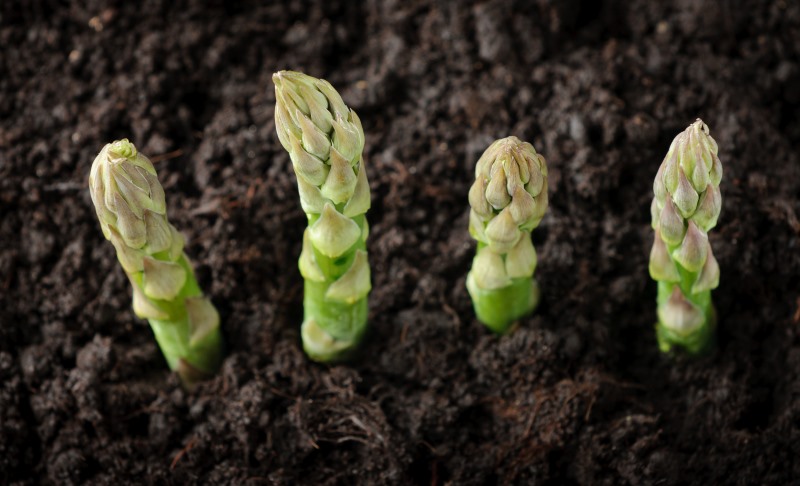
Interesting Facts
Here are some fun facts about this spring vegetable:
- While the word “asparagus” might immediately bring to mind an image of a green vegetable, it actually also comes in less common white and purple colors! White asparagus is grown underground or under plastic domes, and the lack of chlorophyll gives it its shade. Purple asparagus is naturally grown and has a fruity flavor that is often enjoyed raw.
- A study has shown that chickens are incredibly effective at farming asparagus! They can drastically reduce weed growth without damaging the crops (6).
- Asparagus, coming from the salty Mediterranean basins, can tolerate high levels of soil salinity, which is why farmers once used sea salt as a herbicide.
- China farms the most asparagus in the world — at least 57,000 hectares. Meanwhile, Peru, the second-largest producer with 27,000 hectares, exports the most asparagus — around 50 percent (7).
- Asparagus has been important in European culture and can be found in some works of art dating as far back as 1580!
- When it’s really hot outside, asparagus can grow up to seven inches in a single day. They’re cut every day during the harvest period.
- California produces the most asparagus — about 70 percent — in the United States. Stockton City, California, dedicates the entire month of April to celebrating asparagus.
- The asparagus you find in the market usually comes from male plants. When planted, half of the resultant shoots are male and half female. Flowers vary in appearance, and female plants also grow a red berry. Farmers prefer male plants because of their productivity (8).
- Asparagus is actually part of the lily family! Liliaceae is one of the largest plant families and includes onions, leeks, garlic, gladioli, chives, and turnips.
- In Schrobenhausen, Bavaria, in Germany, an entire museum is dedicated to asparagus! The European Asparagus Museum (Europäisches Spargelmuseum in German) has everything you might want to know about asparagus, from its history to its cultivation and beyond (9).
- The asparagusic acid in asparagus is converted to compounds containing sulfur, which then gives your urine a pungent odor, although not everyone can smell it (10).
- Cultivating white asparagus requires considerable work, as it is one of the most labor-intensive vegetables to grow since each spear is handpicked as soon as the tips emerge from the soil. It has to be clipped at the base and then immediately placed in a dark container to preserve its iridescent color (11).
Nutritional Facts
Asparagus is a lovely food ingredient to use in your regular diet because it is chock-full of beneficial nutrients!
In addition, it has almost no fat content and very few calories. It has four grams of carbohydrate and two grams of protein.
Other than that, asparagus contains only vitamins and minerals.
One cup of 180 grams of asparagus is replete with these amazing nutrients that are listed alongside their percentage in relation to the recommended daily values of those nutrients:
- Folate (61%)
- Vitamin K (180%)
- Vitamin C (73%)
- Vitamin B1 Thiamin (8%)
- Vitamin B6 (2%)
- Vitamin A (29%)
- Vitamin B2 Riboflavin (11%)
- Vitamin B3 Niacin (9%)
- Vitamin E (11%)
- Calcium (3%)
- Magnesium (4%)
- Copper (9%)
- Phosphorus (9%)
- Potassium (9%)
- Zinc (5%)
- Manganese (13%)
- Selenium (10%)
- Iron (6%)
- Pantothenic acid (3%)
- Protein (11%)
- Dietary fiber (12%)
These nutrients are among the most advantageous you can find for protecting health.
As you can see from the figures above, one cup of asparagus in the cases of some nutrients may provide almost the total intake recommended for a day or more.
For instance, one cup of asparagus will provide you with more than enough vitamin K and close to enough vitamin C and folate.
For other nutrients that represent a lower proportion to the recommended value, you should include other sources of those nutrients in your diet as well, but whether it is very prominently present in asparagus or only in a small amount, each of these nutrients brings along with it several health benefits that are explained below.
Health Benefits of Asparagus
Provides Bone Health
One important function of vitamin K is providing bone density.
A cup of asparagus provides you with 70 percent of the vitamin K you need for the day.
It helps you absorb more calcium, and you can thereby prevent osteoporosis and bone fractures.
A study involving Korean adults has shown that low vitamin K in the diet leads to low bone mineral density.
This may cause hip or other types of fractures. If you want strong, healthy bones, eat lots of asparagus! (12, 13, 14, 15)
Anti-Inflammatory Benefits
Antioxidants are amazing.
They neutralize the free radicals in our body and prevent a range of harmful effects, including inflammation.
Asparagus helps fight against such problems as type 2 diabetes, cancer, and heart diseases, and the antioxidant glutathione in asparagus slows down aging.
It protects skin from inflammation through UV radiation or pollutants in the environment (16, 17, 18).
Purple asparagus, in particular, is full of anthocyanins, which reduce toxic elements in the skin and keep it free from sun damage (19).

Increases Urine Production
A natural diuretic, asparagus can help increase urine production in the body.
By expelling water from the body, it reduces the concentration of superfluous salts and fluids.
This is helpful for people suffering from edema, which is the retention of water in the body tissues, or high blood pressure (20).
As a result, swelling and other effects of extra fluids in the body can be eliminated.
They can relieve stress on the kidneys and protect the glomeruli from wear and tear.
A study on rats has shown that asparagus possesses an anti-urolithiasis effect, which can help prevent or cure urinary tract infection by eliminating the formation of stony concretions in the tract (21).
Good for Digestive Tract
Asparagus has a lot of soluble and insoluble fiber, which is crucial for digestive health.
Soluble fiber attracts water and turns gluggy and can slow down the digestive process.
Meanwhile, dietary fiber removes mucoid plaque and other toxins from the gut while being expelled.
You can also expect regular bowel movements, relief from constipation, and some protection from colon cancer.
The fiber inulin in asparagus promotes healthy bacteria growth in the gut (22).
Therefore, asparagus helps you maintain a clean and healthy colon.
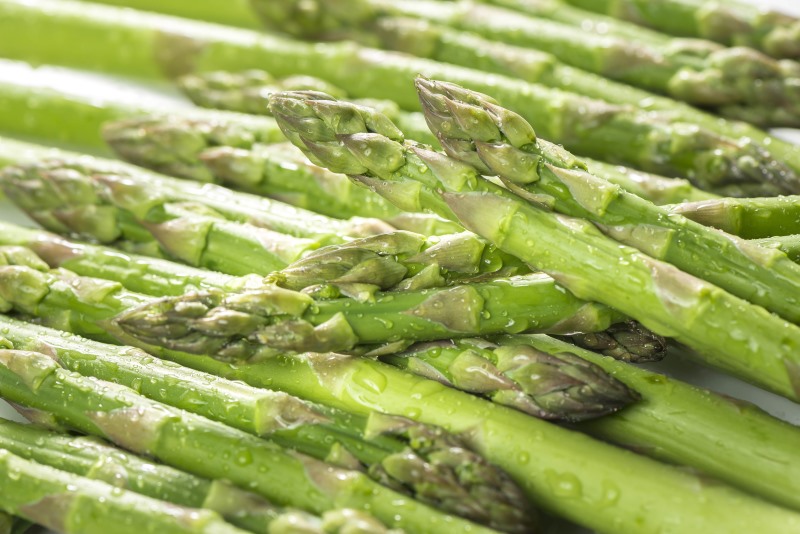
Asparagus and Pregnancy
Expectant mothers should definitely try asparagus to help with their gestation period.
Asparagus has high levels of folate, which is quite important during pregnancy because it aids in nucleic acid synthesis, which is needed for rapid growth, for example, during pregnancy.
Chances of miscarriages or neural tube defects are significantly lowered because of folic acid, while chances of low weight, premature delivery, and retardation decrease (23).
In fact, it might also be important before conception.
A study in male mice showed that folic acid deficiency correlated with a 30 percent higher rate of birth defects (24).
Men should eat your asparagus too!
Destroys Carcinogens
Cancer is a difficult disease to combat, and it seems to be becoming more and more common.
It helps to understand that free radicals may be the cause behind many cancers, and antioxidants can help prevent them.
The sulfur in glutathione found in asparagus can destroy carcinogens in the body and recycle antioxidants.
It is particularly efficient in immunizing against varieties of bone, breast, lung, pancreatic, cervical, and colon cancers.
Since inflammation and chronic oxidative stress often cause cancer, the anti-inflammatory benefits of asparagus can be a great way to ward it off (25).
Folate also protects against harmful and rapid mutation and contributes to preventing cancer (26).
Remember that prevention is better than a cure.
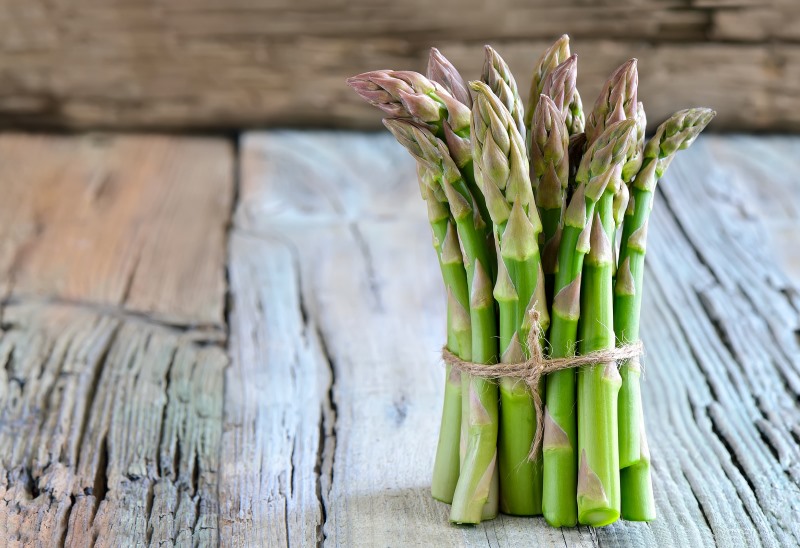
Promotes Weight Loss
Eating asparagus with its low amount of calories can help you suppress your appetite and avoid unhealthy snacking.
It is also a great source of soluble fiber insulin, which will further help you keep your appetite under control.
Similarly, it has vitamin B complex (vitamins B1, B2, B3, and B6), which metabolize glucose and help maintain healthy blood sugar levels.
Without blood sugar crashes, you are less prone to binge eating.
To add to that, it helps avoid bloating.
Nobody wants to look puffy, and the diuretic characteristics of vitamin K along with probiotic growth stimulated by asparagus helps to prevent that! (27, 28)
Fights Depression
Depression is becoming more common every day partly because of increased stress and partly because of high homocysteine levels, which impede the pathway to the brain for nutrients and blood cells.
This affects the production and secretion of some important hormones, such as serotonin, dopamine, and norepinephrine.
These hormones make you feel good and keep your spirits high.
They are not to be underestimated: without being joyful, your mental health is severely affected.
Besides regulating your mood, these hormones also regulate sleep and appetite, so including asparagus in your diet can help ensure emotional stability.

Heart Health
A healthy heart is vitally important for maintaining a healthy life.
A high homocysteine level increases the chances of heart disease.
People with above-average levels are 1.7 times more likely to develop heart disease and 2.5 times more likely to suffer a stroke than others.
The B vitamins in asparagus can lower the homocysteine levels in the body, according to results from controlled studies.
Meanwhile, soluble fiber can reduce cholesterol levels (29, 30).
Blood-Sugar Regulation
The soluble fibers and antioxidants in asparagus can help prevent type 2 diabetes.
The soluble fiber can modulate the absorption of glucose in the digestive tract, while the antioxidants remove inflammation associated with diabetes.
In research conducted on diabetic rats, insulin production had improved after twenty-eight days as well as beta cell function (31, 32).
The B vitamins also help metabolize starches and sugars and help manage blood sugar.
Further, calcium, which is present in asparagus, has been shown to have a direct effect on the pancreatic cells that regulate insulin secretion.
A study has indicated that long-term intake of calcium along with vitamin D can reduce the risk for type 2 diabetes by 33% (33, 34).
Similarly, people with diabetes are ten times more likely to have a magnesium deficiency, and adding magnesium to your diet could reduce chances of diabetes by 15%! (35, 36)
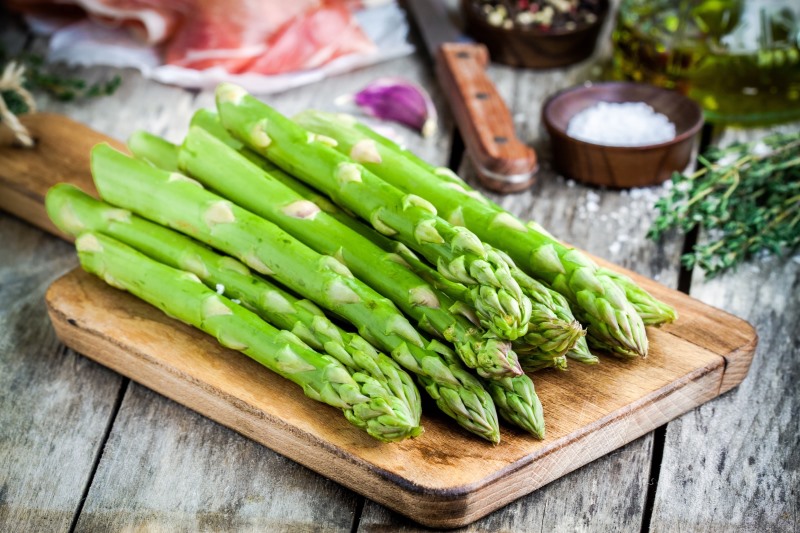
Skin Health
Asparagus has a compound called niacin, which is excellent for getting rid of acne (even the severe type).
It helps reduce skin inflammation and irritation.
It is also very helpful in treating inflammation-related skin disorders, such as bullous pemphigoid and granuloma annulare (37).
Its antioxidant glutathione fights free radicals and reverses the aging effect of sun damage on the skin.
It also helps heal skin wounds faster (38, 39).
The vitamin C found in asparagus is also important in this regard.
A study conducted with over 4,000 women over the age of forty showed that vitamin C reduces wrinkles and dry skin (40).
Another beneficial compound in asparagus is copper, which is required to form the pigments in your skin and hair.
Copper also helps build collagen and produces elastin, which improves the skin’s firmness and elasticity.
Along with vitamin B12, it also prevents premature graying and thinning of hair (41, 42).
Kidney Stone Prevention
If you have uric acid kidney stones, you may have been told to stay away from asparagus.
That is sound advice, since asparagus may lead to your urine being too acidic and worsen your situation (43).
If you aren’t suffering from uric acid kidney stones, however, and want to prevent kidney stones in general, asparagus is a great choice.
It can flush out superfluous salt and fluids from your body as well as toxins in the kidneys, which can help prevent kidney stones from forming (44).
Asparagus also contains vitamin B6, which decreases urinary oxalate production, a factor behind calcium oxalate kidney stone production.
A study conducted over fourteen years has shown an inverse relationship between consumption of vitamin B6 and the formation of kidney stones (45).

Menstrual Health
For many women, the four to seven days of their periods are the worst of a month.
PMS, mood fluctuation, cramps, and uncomfortably heavy flows often accompany periods.
Asparagus contains vitamin K and calcium, which can help combat these symptoms if you happen to have them.
Vitamin K regulates our hormones so that you don’t experience cramps and other pains of menstruation.
It is also excellent for clotting of blood and can help control excessive bleeding, further alleviating cramps.
One study has shown that vitamin K injected into the bloodstream can help relieve acute menstrual pain (46).
Calcium also helps relieve PMS symptoms, such as cramps, bloating, breast tenderness, muscle aches, headaches, and moodiness (47).
Boosts Fertility
Asparagus is widely considered a potent aphrodisiac.
Its shape is definitely a factor, but its nutrients are also important.
Asparagus contains vitamin E, which is known to improve the quality of sex hormones and cells in both males and females.
It reduces lipid peroxidation in sperm cells, keeping them healthy and motile, and also thickens the lining of the uterus (48, 49, 50).
Similarly, vitamin C can also nourish sperm cells and increase sperm count, keeping it voluminous and healthy (51).
Folate, too, promotes healthy sperm production in a number of ways.
Mainly, it helps create sperm cells with the correct chromosomal structure that is required for fertilization.
One study has linked the consumption of folate with successful pregnancies (52, 53, 54).
Research has also shown increased levels of estrogen with folate, leading to positive effects on mammary glands, increased blood flow in the genitals, dilated vaginal opening, and hypertrophied muscular walls of the oviduct (55).

Deals with Hangovers
If you have ever gone out for a night of wild drinking and awakened the next day with a raging hangover, you know just how bad it can be.
Hangovers are often accompanied by anxiety, nausea, fatigue, dehydration, and stomach disorders.
Asparagus can help you avoid all that.
Research has shown that the leaves and shoots of an asparagus plant can effectively alleviate unpleasant symptoms after excessive alcohol consumption, which demonstrates a therapeutic benefit of asparagus (56).
It can also reduce the toxicity in liver cells that could occur (57).
Eye Health
B vitamins are great for your eyes.
A study has revealed that vitamin B therapy, which includes intake of folic acid, vitamins B6 and B12 — all present in asparagus — can help prevent age-related macular degeneration.
The control group placebo in the trial was shown to have a higher incidence of deteriorative eye disease (58).
Asparagus also has vitamins A and C, which are rich antioxidants that can prevent oxidative damage to the retina caused by free radicals in the body.
This helps prevent cataracts from forming (59, 60, 61).

Asparagus and Rheumatism
Rheumatism is a disease marked by inflammation and pain in the joints or muscles.
A common type is a rheumatic arthritis, which can cause severe pain and inhibit movement.
Studies have shown that niacin intake can lower joint pain.
It is usually prescribed to treat inflammation and arthritis, but its presence in asparagus can help you get a certain amount without the need for medication.
It has been shown to reduce swelling and joint aches (62).
Copper also reduces inflammation in the joints and repairs connective tissue, helping you relieve pain and stiffness.
Asparagus has been shown to have anti-inflammatory and analgesic properties (63).
Controls Blood Pressure
Another great benefit of asparagus is that it helps control blood pressure.
It contains magnesium, which has blood pressure – related properties.
A highly representative study that used 241,378 participants showed that a diet rich in magnesium reduces chances of stroke by 8 percent (64).
Keep in mind that about half of all cases of stroke are caused by hypertension.
Studies have shown that increasing consumption of calcium can effectively relieve high blood pressure (65, 66).
Calcium affects blood pressure through its other activities, such as muscle activity or changing the metabolism of electrolytes (67).
Rutin has also been shown to ease hypertension.
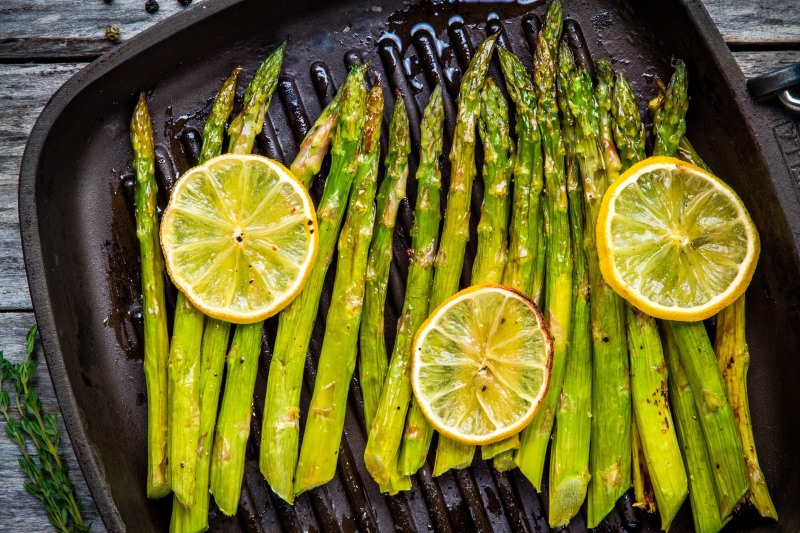
Treats Tuberculosis
Tuberculosis is an infectious disease caused by specific bacteria that usually attacks the lungs.
A severe case of TB can have very severe effects on your health.
Symptoms include vomiting, coughing up blood, fatigue, chills, chest pains, fever, and weight loss.
The roots of asparagus racemosus are known for their effectiveness in treating bronchitis and tuberculosis (68).
These roots improve the functioning of tissues in the lungs and also relieve throat infections (69).
Brain Health
If you are familiar with the impact neurodegenerative diseases, such as Parkinson’s, Alzheimer’s, and Huntington’s, you know that these can be very harmful.
By adding more asparagus to your diet, however, you can lessen your chances of developing such diseases.
Research has linked folate with neural health.
A study involving Korean participants with dementia indicated that they had lower levels of folate, while the control group had higher levels (70).
Studies have also shown an inverse relationship between vitamin B3 levels and a risk for cognitive decline.
It has been shown to protect the brain against Alzheimer’s disease and ADHD (71).
Thiamine is often used to treat memory disorders and can protect you against cerebral syndrome (72).
It is needed for an enzyme process that oxidizes sugars we consume, which then provide fuel for the nervous system (73).
It also ensures proper development of myelin sheaths to protect nerve endings.
Another study has shown that thiamine enhances the speed and clarity of thought in test takers (74).
Vitamin B6 also protects against cognitive impairment (75).
It controls homocysteine levels, inhibiting neuron damage in the nervous system and helps produce serotonin, which helps protect against learning and behavioral disorders (77).

Treats Epilepsy
Epilepsy is a neurological disorder characterized by seizures.
It involves often painful, uncontrollable spasms of the body that limit activity.
For epileptics, asparagus can be a wonderful remedy.
Asparagus is renowned for its herbal therapeutic benefits.
Tribal and nomadic communities have been known to use it for various purposes, including treatment of epilepsy (78, 79).
Increases Cell Growth
In many developing countries, severe copper deficiencies affect the population.
The negative effects can be seen in high rates of stunted growth and underdevelopment in malnourished children.
Asparagus contains copper, which is needed for proper oxygenation of red blood cells.
These are transported all around the body, and without proper oxygenation, organs and other cells cannot develop adequately.
Studies show that deficiency delays growth slows metabolic activity, and leads to people being underweight with stunted height.
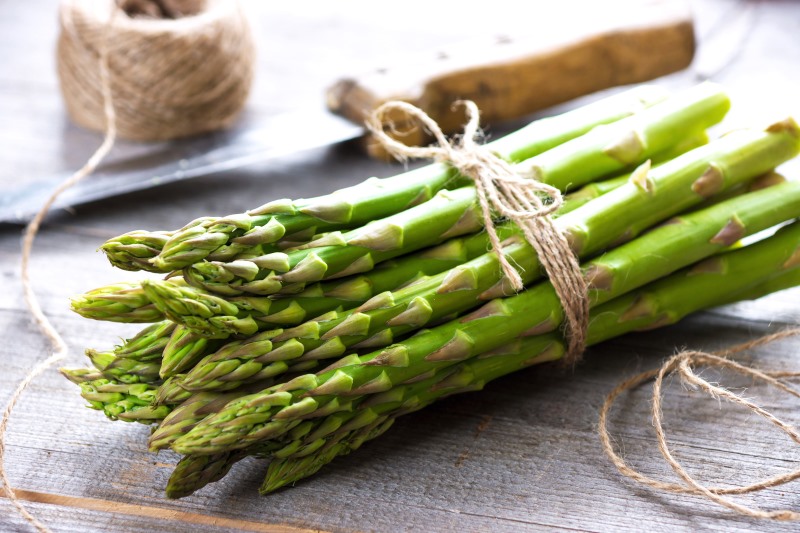
Lowers Blood Cholesterol
You’ve probably heard time and again that high cholesterol levels are bad for you.
Be assured that they are, and you should be taking steps to prevent the buildup of cholesterol.
A great way to do that is by eating asparagus, which is a great source of dietary fiber.
Doing this lowers levels of low-density lipoprotein, one of the biggest enemies to your good health (80, 81).
A study on mice that were fed a high cholesterol diet shows that dietary fiber improves serum and hepatic profiles, helping control cardiovascular disease (82).
For those with high levels of LDL cholesterol and triglycerides and low levels of HDL cholesterol, niacin has been shown to reduce the chances of heart disease (83).
Studies show that niacin is as effective as prescriptive drugs in this regard (84).
Rutin has also been shown to reduce cholesterol.
Elevates Energy Levels
Imagine being bright, alert, and energetic.
Now imagine being fatigued and weary.
Your energy level affects how you perform each day.
Asparagus contains vitamin B, which helps your energy level by supporting thyroid function and cellular methylation (85).
The magnesium in asparagus can help lessen chronic fatigue syndrome, (86) and copper prevents low iron levels, thereby helping you avoid the associated fatigue.
Copper is also involved in the process of synthesis of ATP in the mitochondria.
ATP is the body’s main source of energy.
It also helps protein metabolism, which also boosts energy levels.

Blood Vessels Health
Your blood vessels transport blood throughout your body.
Damage to blood vessels can be especially harmful to your health and life, but you can take a preventive approach by adding asparagus to your diet.
Asparagus has vitamin B6, which is needed to regulate homocysteine in your body.
High levels of homocysteine are correlated with blood vessel diseases and increased chances of a heart attack because plaque can build up in the vessel walls damaged by the accumulation of homocysteine without vitamin B6, inhibiting proper blood flow.
Research indicates that if consumed with folate (which asparagus has lots of!), vitamin B6 can effectively reduce homocysteine (87, 88).
The rutin in asparagus strengthens the blood vessels (and especially hardens arteries), protecting them from wear and tear.
Fights Internal Bleeding
Internal bleeding can be extremely dangerous because the blood loss might prove fatal for your organs.
To control it, you will need vitamin K. Asparagus has vitamin K and can help you get the protection you need.
Vitamin K is known to reduce the threat of bleeding in the liver.
Similarly, it supports blood clotting, which is essential to stop bleeding, whether extraneous or internal.
Newborns with the hemorrhagic disorder are injected with this vitamin to promote blood clotting and prevent bleeding problems (89).
Rutin, a flavonoid present in asparagus, delivers similar results.

Prevents Hearing Loss
As you grow older, your hearing may become weaker.
Studies have shown that the continued intake of folate and vitamin A can help reduce the chances of age-related hearing loss (90, 91).
Hearing loss has also been linked with reduced bone density for a postmenopausal woman.
By preventing loss of bone density, asparagus can also prevent hearing loss (92).
Its antioxidant properties may also help prevent tinnitus, which is usually high-pitched continued ringing in the ear that is quite disturbing.
Improves Mood
Your mood can have an enormous impact on your everyday life.
How you perform, your emotional health and your social well-being are all affected by your mood.
You want to be fresh and happy so that it translates into your professional and social life too.
Vitamin B6 can help you by raising serotonin levels in your bloodstream, keeping your moods high and preventing disorders (93).
Since it is involved in hormone production in the brain, it can effectively treat mood disorders caused by deficiencies in neurotransmitter function along with folic acid (94, 95).
Vitamin C also combats stress and fatigue to elevate your mood (96).
Asparagus also helps improve your mood by treating insomnia and promoting better sleep (97).

Supports Immune System
A strong immune system is necessary because you need it to fight off diseases and harmful foreign bodies.
If it is compromised, you may find yourself becoming susceptible to all kinds of illnesses.
Asparagus can help your immune system through its various nutrients.
First, if your immune system has been affected and you’re stressed, vitamin C can effectively address that issue.
It can also ward off colds and viruses that may affect you from time to time (98, 99).
Since it is an antioxidant, it also reduces free radical damage, keeping related conditions away.
Thiamine helps support the muscle tone of the digestive tract walls and also helps secrete hydrochloric acid needed for breakdown and absorption of nutrients.
When your body is taking in nutrients, it can develop better immunity.
Similarly, studies have linked low levels of vitamin A with increased vulnerability to infections (100).
Muscle Health
Your muscles are vital to your overall health and fitness.
Muscle pain or weakness will restrain you from performing your best in daily activities.
Asparagus has compounds that can improve muscle health, and the magnesium in asparagus is especially effective at combating fibromyalgia, which is characterized by widespread pain in the muscular regions.
Increasing magnesium consumption has been shown to reduce pain and tenderness while improving immune blood markers (101).
Calcium is involved in the release of neurotransmitters in the brain that control muscle movement and also regulate the release of glucose into the bloodstream, which muscles need for energy (102).
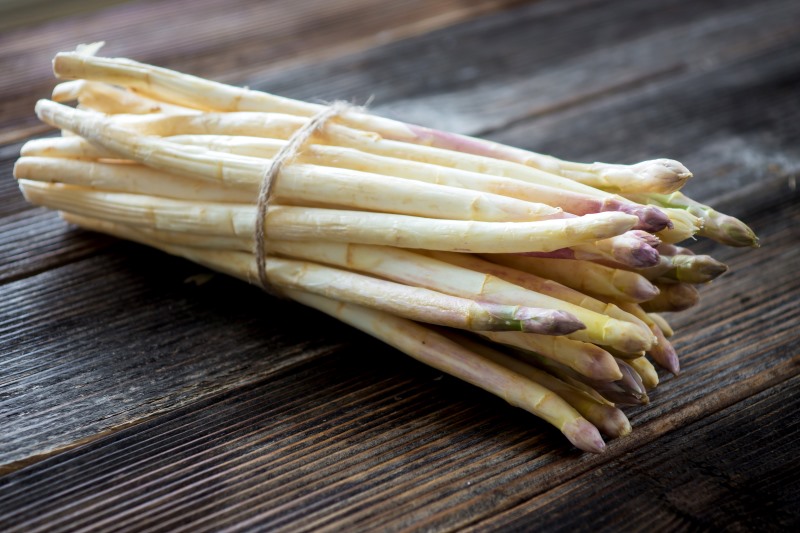
Protects Thyroid Gland
Your thyroid gland is critical for maintaining your health.
It is responsible for secreting thyroxin and other thyroid hormones, which control several important everyday bodily functions, such as appetite, sleep, and temperature.
If your thyroid gland isn’t functioning properly and secretes too little or too much of its hormones, your body is adversely affected, for example, muscle weakness, irritability, fatigue, weight gain or loss, menstrual irregularity, trouble sleeping, and more.
Asparagus has selenium, a deficiency of which can lead to thyroid problems (103).
It effectively protects the gland, regulating the production of oxygen within it and warding off harmful disease-causing antibodies (104).
How to Buy and Store Asparagus
You may be unsure about the best way to buy and preserve asparagus.
You don’t want to have to go to the store and buy it just to find that it isn’t the elegant, delicious kind that Caesar Augustus so loved.
Nor do you want your money and expectations to go to waste because it went bad.
Here are some valuable tips to make sure you do it right:

How to Choose Asparagus
When you’re at the market trying to decide which type of asparagus will give you the best taste and benefits, you should keep in mind a few particular indicators.
Asparagus has a short shelf life, so you want to select the freshest kind available.
Take a close look at all the sprouts so that you know how they look and feel.
If the asparagus is straight, plump, and firm, that it is a good sign. Avoid those that easily bend without splitting.
The tips of asparagus shoots should be firmly closed and have a dark green or purplish hue.
Dry tips or a yellow tinge indicate it has aged or isn’t the best quality (105).
Don’t choose those that are withered, mottled, or blemished.
Stay away from plants with flowers, which is a sign that it is past its optimal level of freshness (106).
If the ends of your stalks are dry or cracked, keep looking.
Moisture should be evident in the stalks (107).
Whether you want thin asparagus stems or the fatter kinds depends on how you like it: thin spears are generally sweeter and tender, while thicker ones are meatier and have a more concentrated asparagus taste (108).
Thin ones may look better when plated up, but if you’re paying the same for each bunch, the larger ones will give you more food.
Know what kind of asparagus you want to buy.
The green ones are generally the most common and fibrous; the purple ones have high antioxidant levels, low fiber content, and are sweeter; the white ones are more or less the same as the green ones except they are lower in nutritional content because they don’t go through photosynthesis and are more expensive because they are much more difficult to produce.
How to Store Asparagus
How do you retain its freshness?
You might have thought that since it is a dry vegetable it can be stored outside or in the pantry, but since it loses its freshness relatively fast, the best idea is to store it in a refrigerator so that it remains good for a few days (109).
An even better idea is to wrap it in loose plastic before storing.
To further retain freshness, trim off the ends of the asparagus shoots and then refrigerate it.
You can help it keep its moisture by wetting paper towels and covering the ends with it (110).
A similar technique that will last up to a week is cutting off an inch from the bottom and immersing it in a cup of water before covering and refrigerating it.
The water might turn murky after a while; if this happens, you should replace it.
Asparagus can also be preserved.
It might not be possible to keep it 100 percent fresh, but it can still taste quite good and be nutritious.
To freeze it, first, blanch it in salt water or citrus juice.
Spread it on a tray and refrigerate for half an hour, after which you can drain the excess liquid and place the frozen asparagus in freezer-safe containers.
To dry it, cut off the edges and then divide the asparagus into 1″ pieces so that it dries evenly.
Steam-blanch them for around three or four minutes, and use dehydrator trays to dry them.
You may also want to consider oven-drying it.
You always have the option of salting, pickling, canning, or lacto-fermenting asparagus too.
These methods won’t give you the original asparagus taste, but they’re close enough and might be worth a try!
How to Clean Asparagus
Before you cook asparagus, you want to make sure you’ve properly cleaned your asparagus sprouts.
They are usually free of pesticides, but there is always the danger of grit and other bacteria entering your body if you don’t clean them well.
First, rinse it under clean and cool water until all the dirt is washed off.
Break off the dry ends from the main stalk.
Then use kitchen towels to dry them.
If your asparagus has a thick and tough outer layer that you don’t like, peel it off (111, 112).

How to Incorporate More Asparagus Into Your Diet
If you’ve tried asparagus but did not enjoy it, it probably wasn’t cooked properly.
Few things are worse than soggy, overcooked, or unseasoned asparagus, but you can do it correctly, and that can lead to asparagus becoming a favorite.
One common mistake to avoid is not getting the correct size of asparagus.
Although you should be more concerned about quality than size, you should be well aware than thinner varieties are easy to overcook, while thicker ones may be woody in texture and less flavorful.
Try to get medium-sized stalks for the best combination; if you can’t, use the thinner asparagus in a raw dish so that you don’t overcook it, and roast, sear or grill the thicker asparagus to maintain maximum flavor.
Don’t bother peeling asparagus.
Most of the stalk, except for the ends, is edible and contributes to the flavor.
Unless your asparagus is really thick and has a tough outer layer, don’t waste time peeling the outside.
That will just reduce the portion of asparagus you have left to cook with.
If you don’t have to snap off the ends of each asparagus with your hands, do one and chop off the same length in all the others from the same lot.
Since bland asparagus is just horrible to taste, blanch them before cooking.
This not only adds flavor but also ensures that it’s cooked well, but you don’t want your asparagus to keep cooking after you’ve finished blanching it.
To avoid that, dip it in cold water.
That will shock the asparagus and stop the cooking process and keep it crispy.
Raw asparagus can be delicious, too, but people often prepare it too far in advance, which creates a weird chewy taste.
To keep it fresh, either chop or peel right before eating, or store it in cool water in the refrigerator (113).
Asparagus is a versatile dish, and you can incorporate it into your diet in many ways.
You can have it for breakfast, lunch, brunch, or dinner.
You can even snack on asparagus between meals.
Asparagus is usually only available during the spring, so take full advantage of that, and use it in as many of your dishes as possible!
You can cook it in the oven, on a grill, in a pan, in the fryer, have it in a soup, or eat it raw.
Make a conscious effort to buy and eat more asparagus.
When you dine in restaurants, try to choose healthy dishes containing asparagus.
Make sure you know the best way of cooking no matter which method you choose to use so that your taste buds approve, and you are encouraged to eat more of it.
Since there are so many different ways of having it, shake things up, and keep it interesting for your palette.
You won’t tire of asparagus after a few meals and will want to keep eating it.
You will like it for the taste, and your body and brain will definitely respond positively! (114)
Simple Recipes
Asparagus is a lovely vegetable to cook with.
As mentioned above, it can be prepared in numerous ways.
If you don’t have too much experience with it and want something time friendly and simple, here are some easy recipes.
Keep in mind all the tips outlined above before you begin.
Oven-Roasted Asparagus
This dish can be prepared in twenty-five minutes or less! And it doesn’t require too many ingredients. You will need the following:
- One bunch of thin asparagus with trimmed edges
- Three tablespoons of olive oil
- One teaspoon of sea salt
- Half a teaspoon of ground black pepper
The following three ingredients are optional, but you can add them according to your taste to enhance flavor:
- One tablespoon of lemon juice
- One clove of minced garlic
- One and a half spoons of grated cheese, preferably Parmesan
The steps are incredibly simple.
First, preheat your oven to 425 degrees Fahrenheit or 220 degrees Celsius so that it is perfect for roasting your asparagus.
This preparation will take only about ten minutes.
Place your asparagus into a mixing bowl, and drizzle the olive oil from above.
Toss it around to coat all parts of the spears.
Then add the rest of the ingredients: salt, pepper, and garlic, and cheese if you wish.
Take out the oven tray and place the asparagus carefully without overlapping.
Depending on how thick the stalks are, bake for twelve to fifteen minutes in the oven.
Take it out, sprinkle some lemon juice, and voila! (115)
Breakfast Asparagus and Eggs
This is a very easy recipe for when you’re running late and need to throw together a quick breakfast.
You will need only these ingredients:
- Five or six stalks of asparagus
- One teaspoon of olive oil
- One-quarter teaspoon of salt
- Two eggs
- Some pepper to top
- One-quarter cup of cheese (goat, blue, Parmesan, mozzarella, or cheddar)
First, remove the woody bottoms of the asparagus.
Heat a skillet over medium heat, and drizzle the olive oil.
Then add the asparagus and salt.
You will need to shake the skillet to nicely coat and season the asparagus.
It needs to be cooked for around four or five minutes to become tender.
Once that is done, spread the asparagus evenly on the pan, and crack the eggs on top.
Sprinkle the cheese, too, if you prefer, reduce the heat, and cover it.
It will take around eight to twelve minutes for the eggs to be done.
Add fresh pepper on top before serving.
It works really well with a piece of crunchy, toasted bread.
Grilled Asparagus in Dill Butter
This is another easy-to-follow recipe and makes a great side dish for brunch or lunch or even dinner.
You will need the following ingredients:
- One pound of asparagus spears
- Two tablespoons of melted butter
- One tablespoon of fresh dill (or else one teaspoon of dried dill)
- One clove of minced garlic
- One-quarter teaspoon of cracked black pepper
- Finely shredded Parmesan cheese
To begin, break off and throw away the woody edges.
Place the asparagus in a mixing bowl, and add butter, dill, garlic, and pepper.
Toss it well to coat and season all sides of the asparagus.
If you have a charcoal grill, place the asparagus over medium charcoal without covering.
If you have a gas grill, preheat it before bringing it down to medium heat.
Grill for around seven to ten minutes depending on the size.
Make sure to turn it from time to time to grill it evenly.
Place on a serving dish when done, and sprinkle the cheese on top.
That’s all there is to it! (116)
Asparagus Soup
For this beautiful soup, you will need:
- Two pounds of asparagus
- The light-colored parts of two leeks, chopped
- One big russet potato, peeled
- Two quarts of low-sodium chicken stock
- One finely diced medium-sized onion
- Three cloves of diced garlic
- Four ounces of fresh baby spinach leaves
- Twenty fresh basil leaves
- One-quarter cup of heavy cream
- Two tablespoons of olive oil
- Two tablespoons of fresh lemon juice
- Salt and ground white pepper for taste
You may be overwhelmed by the list of ingredients, but you can easily find all these at home, and the directions are quite simple.
The nice thing about this recipe is that you don’t have to throw away the edges.
Trim your asparagus stalks, place the woody ends with the chicken stock, and bring it to a boil.
Then reduce the heat and allow it to simmer for ten minutes.
Then remove the pan, and throw away the stems.
In another pot, heat the olive oil and sauté the leeks, garlic, and onion with the salt and pepper.
Then add the diced potato and the stock, and keep it under heat until the potatoes cook.
Then add the rest of the asparagus, and cook it for around five minutes.
Then add the basil and spinach leaves, and add cream and more salt and pepper after a minute.
Remove it from heat and use a mixer, food processor, or blender to finish the soup.
Pass it through a fine sieve.
Serve it hot, or chill it in ice water.
You can add cream for added flavor.

Precautions
Consuming too much asparagus can have negative effects, and you should take certain precautions.
For some people, it can be bad for you in small amounts.
Many people experience allergic reactions to other vegetables of the lily family, such as onions and leeks.
If you’re one of them, you may be allergic to asparagus as well.
A mild allergy may irritate your skin and eyes, cause a rash or an upset stomach.
A more severe allergic reaction could mean nasal congestion, swelling, wheezing, asthma, cramps, diarrhea, lightheadedness, or hives (117).
For some people with smell hypersensitivity, asparagus could result in foul-smelling urine.
This may be an unpleasant experience (118).
Since asparagus is a diuretic and can increase lithium levels in the body, you might experience the detrimental effects of a high-lithium concentration if you eat too much.
There are many such effects, such as nausea, diarrhea, dizziness, muscle weakness, fatigue, weight gain, swelling, fine tremors, frequent urination, and dehydration.
It might also lead to skin disorders, such as acne or psoriasis, an irregular heartbeat, or exacerbate thyroid problems.
Excessive consumption could also harm the development of a fetus inside the womb or poison breast milk.
Asparagus is often used for birth control in medicine, so it is known to change hormonal balances.
Pregnant and breastfeeding women should avoid it in large medicinal amounts (119, 120).
Conclusion
Asparagus is clearly extremely beneficial in many ways.
Aside from its health benefits, it is delicious, easy to cook with, and has few side effects.
Considering how it can be so beneficial for your health and wellness, you should try to have more of it.
It may not be the first vegetable you think of when preparing lunch or dinner, but try to add it to your diet.
Your body will thank you later with good health!
FDA Compliance
The information on this website has not been evaluated by the Food & Drug Administration or any other medical body. We do not aim to diagnose, treat, cure or prevent any illness or disease. Information is shared for educational purposes only. You must consult your doctor before acting on any content on this website, especially if you are pregnant, nursing, taking medication, or have a medical condition.
HOW WOULD YOU RATE THIS ARTICLE?
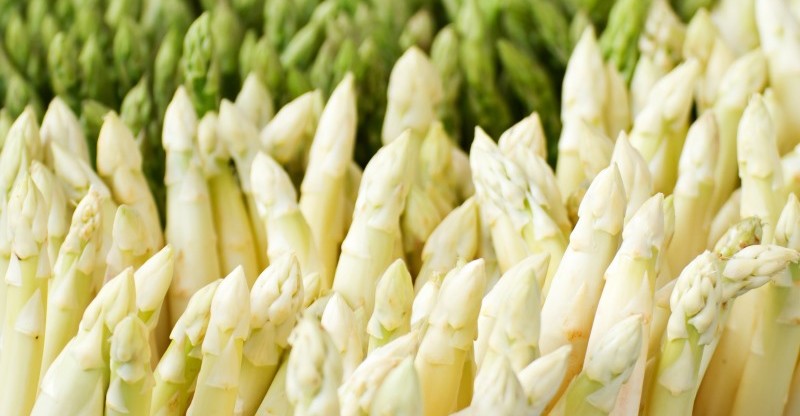






Wow Helen, I`ve always know I just loved asparagus but had no idea how far reaching the health benefits were.
Great site!
Thanks a lot, Tez!
Asparagus is one of my favorite vegetables and it does have a lot of health benefits. I’ve always wondered how many benefits does it have, though. So it was very interesting personal project for me to write about this topic :). I’ve very happy you liked it too.
Helen
I’m also impressed of health benefits of asparagus!!!wow…
but when I’m cooking asparagus it’s always woody!!!What could be the reason???
Asparagus is quite firm itself so you have to cook it longer to make it soft and tender. You can try to cook it in the oven. Also, choosing thinner spears may help.
good
Thank you 🙂 !
Can I use asparagus in my morning smoothie? What veggies or fruits is it better to mix asparagus with?
Can asparagus help with washing out the kidney stones? Or is it just working on prevention?
I often buy canned asparagus. Do I get all the benefits? Or it’s better to eat it only raw?
How much asparagus is too much?
thank you hellen, you are the best.